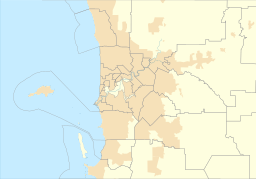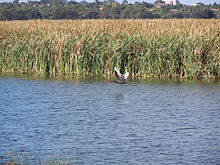| Herdsman Lake | |
|---|---|
 Looking across a dredged section of the lake towards Perth Looking across a dredged section of the lake towards Perth | |
 | |
| Location | Perth, Western Australia |
| Coordinates | 31°55′12″S 115°48′25″E / 31.92000°S 115.80694°E / -31.92000; 115.80694 |
| Basin countries | Australia |
| Designation | Herdsman Lake Regional Park |
| Max. length | 2.5 km (1.6 mi) |
| Max. width | 2 km (1.2 mi) |
| Surface area | 3 km (1.2 sq mi) |
| Settlements | Perth |
Herdsman Lake (Nyungar: Njookenbooro) is a freshwater lake located on the Swan Coastal Plain, 6 kilometres (3.7 mi) north-west of Perth, Western Australia, in the suburb of Herdsman. The main shared-use path around the lake is approximately 8 kilometres in length, whilst the wetland perimeter of the lake is approximately 7.5 kilometres.
Description

The lake is encompassed by Herdsman Lake Regional Park. It measures 2.5 kilometres (1.6 mi) in length, and 2 kilometres (1.2 mi) in width, totaling over 3 square kilometres (1.2 sq mi). The perimeter of the lake is dredged to provide permanent open water, 15% of the area, during the dry summer months. The lake is a wildlife sanctuary, with birdwatching a popular activity.
Almost 80% of the lake is covered with Typha rush (Typha orientalis), an introduced weed. In summer, most of the lake is dry. 15% of the lake is permanent deep water.
The Herdsman Main Drain is a 4-kilometre (2.5 mi) x 1,000-millimetre (39 in) underground pipe drain carrying excess water from the lake to its outflow at City Beach.
History
Pre-colonial use
The Noongar name for Herdsman Lake is Ngurgenboro (with various other spellings). The lake was used as a food source and meeting point. The Noongar people primarily camped on the higher ground around the lake's northern and western edges, in order to avoid flooding and minimise exposure to midges and mosquitoes. The roots and stems of bullrushes supplied carbohydrates and the lake was also "an important source of protein in the form of frogs, tortoises, crustaceans and water fowl".
Colonial period
Following the creation of the Swan River Colony in 1829, British settlers originally named it the Great Lake, being the largest of the series of lakes and wetlands to the north of the Perth townsite. By the mid-1830s it had become known as Herdsman's Lake. In 1837, Surveyor-General John Septimus Roe investigated the possibility of draining Lake Monger into Herdsman Lake, setting aside a reserve for a drain which was later cancelled. Unlike the lakes closer to the townsite, Herdsman and Monger were "left relatively undisturbed" in the early years of the colony as they were considered too far away to develop into residential land. However, the fertile land around them was subdivided and used for agricultural purposes. The lake itself was a "favourite resort for duck shooters".
In 1854, Benedictine monks were granted a large portion of land near the lake and established orchards and vineyards. The Catholic Church came to own most of the land and used it to graze cattle, while a number of market gardens were also established. The Western Australian gold rushes brought a population influx and saw the lake used for raising pigs and poultry as well as growing crops.
Drainage scheme
In 1912, most of the swamps in Osborne Park were drained into Herdsman Lake in order to improve growing conditions for the market gardens in that suburb. The Public Works Department subsequently began a scheme to drain the entirety of Herdsman Lake and reclaim the land for market gardens. The land formed part of a soldier settlement scheme for World War I veterans with around 518 hectares (1,280 acres) acquired by the state government from the Catholic Church. Construction on the drainage scheme began in 1921 and was completed in 1925, with the drain including a tunnel of 3.2 kilometres (2.0 mi) leading to an ocean outlet in Floreat.
The drainage scheme "was never successful; blocks sold slowly, there was continual flooding in winter, and soils were largely unsuitable for horticulture". The scheme, which cost £116,362 (equivalent to $10,700,000 in 2022), lowered the water level in Herdsman Lake from a peak seasonal depth of 3 metres (9.8 ft) to a depth of only 0.5 metres (1.6 ft). The soils proved too peaty and acidic for crops to be grown successfully, and the decrease in water level contributed to a replacement of native bulrushes with introduced species. The lake was instead used for cattle grazing into the 1970s, while at various points Herdsman Lake was also considered for metropolitan water supply purposes, as the site of an airport, for peat harvesting, and as a rubbish dump.
Preservation
In 1955, the Plan for the Metropolitan Region, Perth and Fremantle recommended that Herdsman Lake be set aside for "parks and recreation" purposes, which was endorsed by the Metropolitan Region Scheme formally approved by the state government in 1963. In 1976, the Metropolitan Regional Planning Authority produced the Plan for Herdsman Lake, which was subsequently adopted with amendments by the state government as the Herdsman Lake Concept Plan. The concept plan called for the central area of the lake to be preserved by creating a "moat" of deep channels around the periphery, resulting in the creation of four areas of deep water: Floreat Waters, Floreat Lakes, Popeye Lake and Powis Lake. The plan also allowed for the development of residential areas on the north-west and south-west fringes of the lake, and expanded the industrial area to the north-east.
The Herdsman Lake Wildlife Centre was opened in 1984, following a fundraising effort by the Gould League of Western Australia, the Royal Australasian Ornithologists' Union, and the World Wildlife Fund. Herdsman Lake was made a regional park in 1997, to be co-managed by the Department of Conservation and Land Management and the City of Stirling.
Attractions
Attractions within the park include the Olive Seymour Boardwalk, Herdsman Lake Discovery Centre and Settler's Cottage. It also contains a statue created by Pietro Porcelli, which formerly sat atop the now-demolished AMP Chambers building, which was rescued and placed on one of the islands. Walking, cycling, picnicking, birdwatching and wildflower spotting are popular activities in the park. Disabled access is provided.
Wildlife
Mammals
Herdsman Lake supported a population of kangaroos until the early 1950s. Quendas, brushtail possums and western brush wallabies were present until the 1960s.
Reptiles
Herdsman Lake is known for inhabiting hundreds of tiger snakes.
Birds
More than 160 species of bird have been recorded at Herdsman Lake, including some notable sightings and endemic species to the region. Notable sightings include:
- Purple Heron in February 2013, a vagrant to Australia
- Striated Heron in July 2013, vagrant this far south in Western Australia
- Collared Pratincole in January 2019, first found at Point Walter and later relocated at Herdsman Lake, a first record for Australia
- Wandering Whistling-Duck in May 2019, vagrant this far south in Western Australia
- Eastern Yellow Wagtail in January 2020, vagrant this far south in Western Australia
See also
References
- ^ www.wagouldleague.com.au Archived 9 April 2006 at the Wayback Machine About Herdsman Lake Regional Park. Accessed 21 February 2005.
- "Archived copy" (PDF). Archived from the original (PDF) on 13 March 2011. Retrieved 13 April 2011.
{{cite web}}: CS1 maint: archived copy as title (link) - "Archived copy" (PDF). Archived from the original (PDF) on 18 February 2011. Retrieved 13 April 2011.
{{cite web}}: CS1 maint: archived copy as title (link) - ^ Harvey 2004, p. 46.
- Blyth & Halse 1986, p. 29.
- Bekle & Gentilli 1993, p. 445.
- Bekle & Gentilli 1993, p. 447.
- ^ Bekle & Gentilli 1993, p. 453.
- ^ Harvey 2004, p. 47.
- ^ Blyth & Halse 1986, p. 30.
- ^ Harvey 2004, p. 48.
- ^ Blyth & Halse 1986, p. 31.
- Harvey 2004, p. 49.
- "Perth lakes crawling with hundreds of tiger snakes, researcher confirms". ABC News. 22 December 2020. Retrieved 27 October 2024.
- "Sick snakes a cause of concern for Perth's wetlands". 28 May 2024. Retrieved 27 October 2024.
- "Herdsman Lake, Stirling, WA, AU - eBird Hotspot". ebird.org. Retrieved 22 March 2022.
- Hart, Nick. "eBird Checklist - 22 Feb 2013 - Herdsman Lake - 4 species". ebird.org. Retrieved 22 March 2022.
- Hart, Nick. "eBird Checklist - 2 Jul 2013 - Herdsman Lake - 1 species". ebird.org. Retrieved 22 March 2022.
- Groom, Geoffrey. "eBird Checklist - 31 Jan 2019 - Herdsman Lake - 12 species". ebird.org. Retrieved 22 March 2022.
- Heikaus, Andreas. "eBird Australia Checklist - 6 May 2019 - Herdsman Lake - 45 species". ebird.org. Retrieved 22 March 2022.
- Graff, John. "eBird Checklist - 16 Jan 2020 - Herdsman Lake - 71 species". ebird.org. Retrieved 23 March 2022.
Sources
- Bekle, Hugo; Gentilli, Joseph (1993). "History of the Perth lakes". Early Days. 10 (5): 443–460.
- Blyth, John; Halse, Stuart A. (1986). "Herdsman Lake: inner city sanctuary" (PDF). Landscope. 2 (2): 28–34.
- Harvey, Nicole (2004). "Refuge in the city: Herdsman Lake Regional Park" (PDF). Landscope. 20 (1): 44–51.
External links
- Herdsman Lake Wildlife Photographs
- Herdsman Lake Wildlife Centre
- Parks and Wildlife Service: Herdsman Lake Regional Park
- Herdsman Lake Regional Park management plan
| Regional parks in Western Australia | |
|---|---|
| Protected areas of Western Australia |